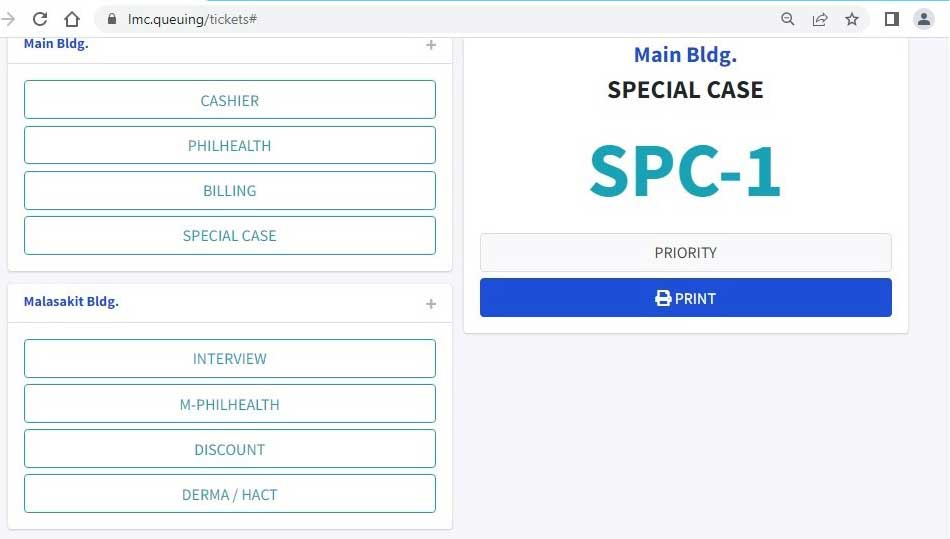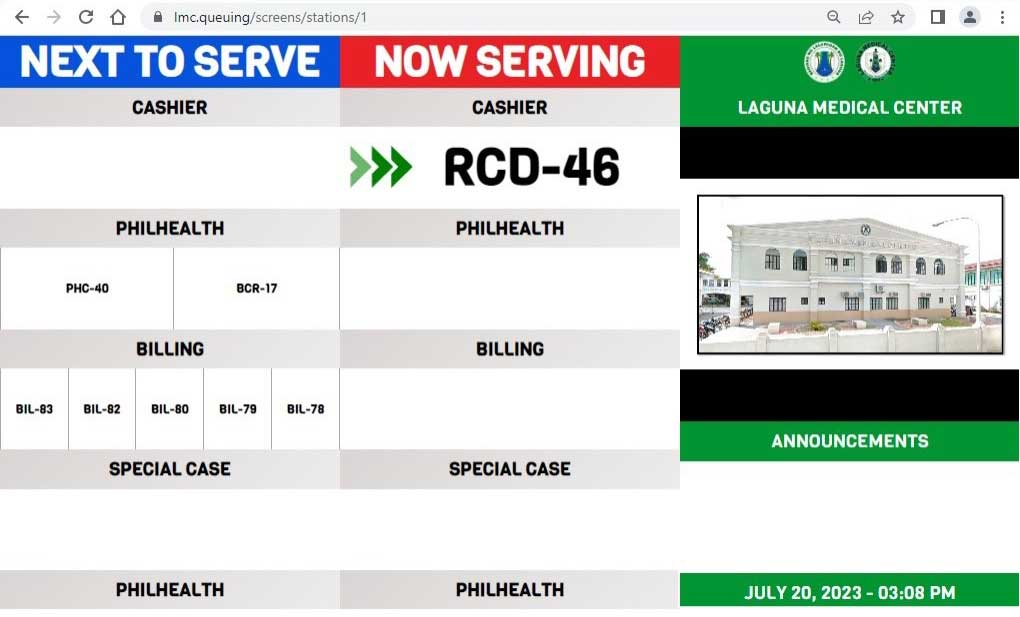Overview
The Laguna Medical Center Queuing Management System (QMS) is a technology-driven solution designed to optimize patient services efficiently. The primary challenge it addresses is the inefficient utilization of resources and time in managing patient queues. The QMS optimizes the patient journey, eliminating long wait times, streamlining operations, and enhancing resource allocation. Key features include automated routing, priority handling for special cases, open-source adaptability, and educational health videos. By ensuring patients receive prompt services with minimal hassle, the QMS enhances productivity, resource management, and overall patient satisfaction.
Challenge
The Laguna Medical Center faced lengthy patient wait times and chaotic queues. The manual queuing system often resulted in disruptions and mismanagement of patient flow, necessitating additional administrative personnel to handle the queues.
Moreover, the lack of a structured approach adversely affected the quality of patient care, with some individuals needing timely attention due to queue disruptions or record misplacement. This undermined the medical center’s ability to efficiently serve its patients, manage resources, and maintain high healthcare standards.
Solution
The introduction of the QMS aimed to tackle the challenges by automating and streamlining the queuing process, ensuring prompt services for patients, and optimizing resource allocation, ultimately enhancing productivity and healthcare service quality.
Its key features and innovations include:
Automated Routing: Unlike traditional queuing systems that require patients to obtain a new ticket for each service, the QMS utilizes advanced routing. Once patients receive their initial ticket, they are automatically directed to subsequent services based on their previous ticket number, eliminating the need for constant returns to the ticket booth, reducing wait times, and streamlining the process.

Priority Flagging: The QMS enables operators to prioritize patients based on their specific needs, such as individuals with disabilities. This ensures that vulnerable patients receive more convenient and efficient service, demonstrating a commitment to inclusivity and improved patient care.

Open Source Software: One remarkable aspect of this system is its use of open-source software. This allows for easy replication and modification by other developers and institutions, making it adaptable for similar queuing management needs across various organizations.

Smaller File Size: The QMS boasts smaller files compared to similar systems, facilitating replication in other offices and institutions while reducing hardware and software resource requirements.

Educational Health Videos: The QMS goes beyond mere queue management by incorporating the innovative feature of playing educational health videos while patients wait, providing patients with essential health knowledge and encouraging healthier lifestyles.

Productivity Gains, Outcomes, and Impact
According to Randolf Abadier Jr., Assistant Systems Administrator, the QMS streamlined patient flow by automating routing, reducing the time patients spend in queues from more than an hour to 15 minutes, and enhancing service efficiency. The system seamlessly assigns patient ticket numbers and routes them to the appropriate departments, preventing long waits and disruptions.
Crystal Jade Gache, a Social Worker, highlighted that the QMS effectively controls the number of people entering the office, ensuring manageable client interviews for better time management. Patients no longer endure long, chaotic lines but can sit comfortably, knowing the system will notify them when it’s their turn.
Dr. Judy Rondilla, Chief of Hospital, emphasized that although patients initially experienced confusion, they quickly adapted, improving overall satisfaction. Furthermore, the priority flagging feature assists vulnerable patients, offering a more convenient and respectful service.
The QMS also provides real-time data insights into patient volumes and queue lengths, which is invaluable for resource allocation and staff management. It allows the hospital to optimize operations according to demand, significantly improving productivity.
Jonel Osio, Supervising Administrative Officer, noted that the QMS has made processing faster and more convenient, ensuring efficient staff resource utilization and reducing administrative bottlenecks, leading to a more productive work environment.
Dr. Rondilla shared that the success of the QMS has inspired plans for expansion to other departments and even other hospitals, fostering a culture of continuous improvement and knowledge sharing.
While exact statistics are not provided, the qualitative feedback from key informants strongly suggests that the QMS has led to productivity gains, including time savings, improved resource utilization, and enhanced patient satisfaction. These outcomes collectively demonstrate how the intervention has positively impacted the Laguna Medical Center’s operations and patients, aligning with the core goals of public-sector productivity.
Lessons Learned and Challenges in Implementing the Intervention
Key lessons learned from the implementation of the Laguna Medical Center’s QMS include the importance of comprehensive user training to ensure a smooth transition and efficient utilization of the system. Users’ feedback, such as the request for an “undo” feature, highlights the need for continuous improvement in the user experience, making the system more user-friendly and reducing errors.
Improvements in the display functionality have been suggested, such as seeing all tickets on the dashboard, enhancing visibility, and assisting staff in resource allocation and patient prioritization.
Due to the sensitive nature of patient data, ensuring robust data security measures is crucial. Continuous assessment and enhancement of data security protocols are necessary to safeguard patient information.
As the QMS expands to other departments and facilities, scalability and adaptability to different contexts and needs are vital, as each department or facility may have unique requirements that must be addressed during implementation.
Patient feedback and the initial confusion during the transition period highlight the importance of patient education, emphasizing the need for clear and accessible information for patients on how to use the QMS to improve their experience and reduce misunderstandings. Implementing a structured feedback mechanism can help gather insights from users and patients, enabling continuous improvement in the system’s functionality and overall effectiveness.
In conclusion, the lessons learned and potential areas of improvement for the Laguna Medical Center QMS revolve around user training, user-friendly features, display functionality, data security, scalability, patient education, and feedback mechanisms. Addressing these aspects can contribute to the system’s ongoing success and positively impact operational efficiency and patient satisfaction.
Resources
6 winning lgus in Digital Governance Awards 2019 get China trip. Philippine Information Agency. (2019, November 29). https://www.pna.gov.ph/articles/1087200
